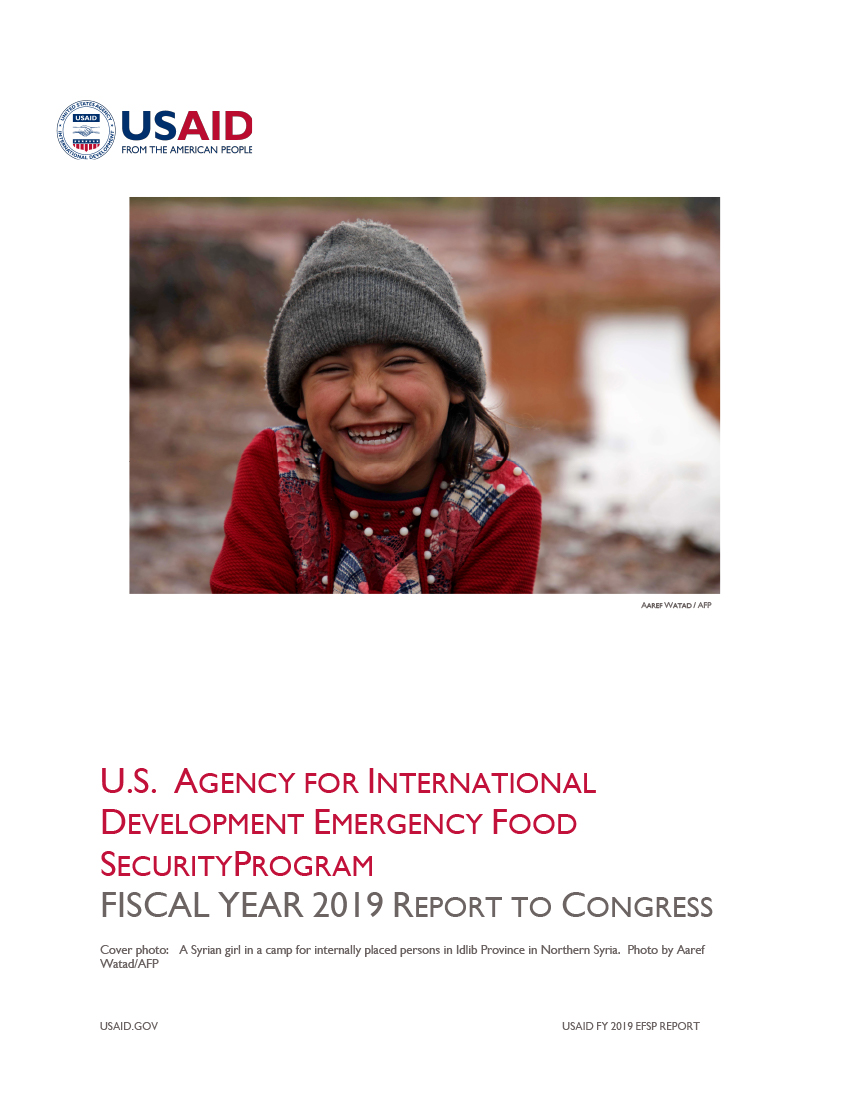Speeches Shim
The U.S. Agency for International Development (USAID) submits this report pursuant to the annual requirement added by the Global Food SecurityAct of 2016 (Public Law [P.L.] 114-195), as reauthorized in the Global Food Security Reauthorization Act of 2017 (P.L. 115-266). The report describes how USAID used funding from the International Disaster Assistance (IDA) account, through the Emergency Food Security Program (EFSP), to address food-insecurity in emergency situations by using market-based approaches, including local, regional, and international procurement (LRIP), and cash and voucher assistance for food.1 This report covers Fiscal Year (FY) 2019.
PURPOSE AND PROGRAM OBJECTIVES
USAID’s Office of Food for Peace (FFP) within the Bureau for Democracy, Conflict, and Humanitarian Assistance (DCHA, soon to be the Bureau for Humanitarian Assistance in FY 2020) delivers two main types, or modalities, of food assistance: 1) Food shipped from the United States authorized under Title II of the Food for Peace Act (Section 1691 of Title 7 of the United States Code [U.S.C.] et seq.); and, 2) Market-based food assistance and essential complementary activities, authorized in both the Food for Peace Act and the Foreign Assistance Act (Section 2151 of Title 22 of the U.S.C. et seq.). In FY 2010, DCHA/FFP began using market-based food assistance through the IDA account. The Global Food Security Act of 2016 (Section 7 of P.L. 114-195) reauthorized the program as the EFSP, and the Global Food Security Reauthorization Act of 2017 (P.L. 115-266) reauthorized funding for the program.2
The Global Food Security Act states the purpose of EFSP is “to mitigate the effects of manmade and natural disasters by utilizing innovative new approaches to delivering aid that support affected persons and the communities hosting them, build resilience and early recovery, and reduce opportunities for waste, fraud and abuse.” The Global Food Security Reauthorization Act extended authorization of the EFSP through FY 2023.
EFSP uses principally market-based modalities, including interventions such as LRIP, cash transfers for food, and food vouchers. DCHA/FFP uses four criteria to determine which modality to employ in a given context: market appropriateness, feasibility, project objectives, and cost.3 Additional restrictions on LRIP affect the source and origin of commodities4 to ensure DCHA/FFP’s activities reinforce developing markets to the greatest extent possible.
1 Definitions of principal modalities are in Appendix A.
2 Global Food Security Act of 2016: https://www.congress.gov/114/plaws/publ195/PLAW-114publ195.pdf; Global Food Security Reauthorization Act of 2017: https://www.congress.gov/115/plaws/publ266/PLAW-115publ266.pdf
3 For definitions of criteria, refer to the Modality Decision Tool for Humanitarian Assistance. Available at: https://www.usaid.gov/documents/1866/modality-decision-tool-humanitarian...
4 “Source” means the country from which a commodity is shipped to the cooperating/recipient country or the cooperating/recipient country itself, if the commodity is located therein at the time of the purchase, irrespective of the place of manufacture or production, unless it is a prohibited source country. “Origin” means the country where a commodity is mined, grown, or produced. Award Requirements for Source and Origin of LRIP available at: https://pdf.usaid.gov/pdf_docs/PA00TVW5.pdf


Comment
Make a general inquiry or suggest an improvement.